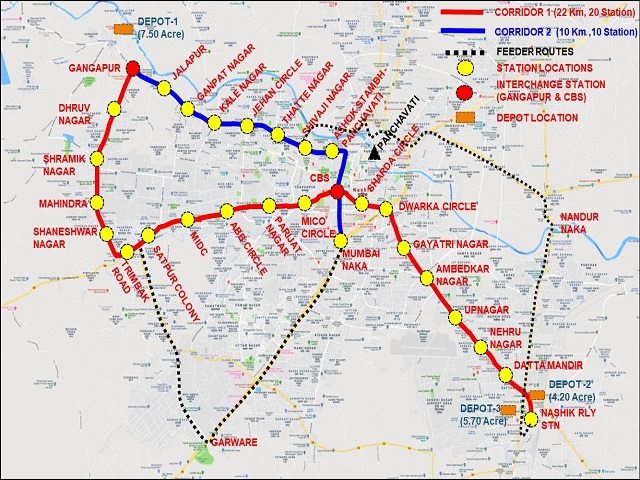In a bid to boost urban infrastructure, Finance Minister Nirmala Sithraman launched schemes worth Rs. 18,000 crores to support augmentation of public bus transport services. The scheme will facilitate deployment of innovative PPP models to finance, acquire, operate and maintain over 20,000 buses.
Union Budget 2021: 20 Interesting Facts About Indian Budget
The scheme is introduced to boost the automobile sector, provide stimulus to economic growth, create employment opportunities for the youth and enhance ease of mobility for urban residents.
FM Nirmala Sithraman stated that a metro rail network of 702 km is already operational pan India and another 1,016 km of the metro rail and RRTS network is under-construction in 27 Indian cities.
Metro Lite and Metro-Neo technologies will be deployed to provide metro rail systems in Tier-2 cities and the peripheral areas of Tier-1 cities, at much lesser costs with the same experience, convenience and safety.
India's first Metro-Neo will be adopted in Maharashtra's Nashik. Metros in Kochi, Chennai, Bengaluru, Nagpur and Nashik will get funding from the Central Government.
What is Metro-Neo Project?
It is a Mass Rapid Transit System (MRTS) that aims to provide a comfortable, rapid, energy-efficient and less noisy transport medium in the city of Nashik. The project will be implemented by Maharashtra Metro Rail Corporation Ltd (Maha-Metro).
In 2019, the feasibility report was made in consultation with the Nashik Municipal Corporation. M/s RITES Limited proposed a Detail Project Report (DPR) was prepared by and after approval of the State Government, it was sent to Government of India for sanction. The Report has identified a 32 km main route and a 24 km feeder route for the implementation of Metro-Neo project.
Frequency of Metro-Neo service: There will be a train service every two minutes. The main elevated corridors will have a capacity of 15,000 PHPDT (peak hour peak direction traffic).
Metro-Neo stations: They will be similar to other Metro rail stations and will house staircases, lifts, escalators and information display for the passengers. The station entry and exit will be provided on both sides of the road.
Electric Bus Coaches:
Length: Metro-Neo service will comprise of electric bus coaches with a length of 18 to 25 metres.
Capacity: It will have a capacity to carry 180 to 240 passengers at a time.
Power supply: AC electric coaches will draw power from an overhead electric wire with 600-750 V DC supply.
Other Features: The busses will also comprise of automatic door closing system, level boarding, comfortable seats, passenger announcement system, and an information system with an electronic display.
Feeder Buses:
Length: The length of the feeder buses will be 12 to 13 metres.
Capacity: It will have a capacity to carry 60 to 70 passengers at a time.
Power Supply: The coaches will operate on battery on the feeder routes and will also run on the Main corridors and get charged during running by overhead traction.
Routes: They will run on the existing roads on two feeder routes-- Satpur Colony via Garware to Mumbai Naka and Nashik Road via Nandur Naka to Shivaji Nagar.
Metro-Neo in Maharashtra's Nashik:
Metro-Neo in Nashik will have two corridors. These are as follows:
1- Corridor 1: A 10-km long route having 10 stations-- starting from Gangapur, Jalapur, Ganpat Nagar, Kale Nagar, Jehan Circle, Thatte Nagar, Shivaji Nagar, Panchavati, CBS and ending at Mumbai Naka.
2- Corridor 2: A 22-km long route having 20 stations-- starting from DHRUV Nagar, Shramik Nagar, Mahindra, Shaneshwar Nagar, Trimbak Rd, Satpur Colony, MIDC, ABB Circle, Parijat Nagar, MICO circle, CBS, Sharda Circle, Dwarka Circle, Gayatri Nagar, Ambedkar Nagar, Upnagar, Nehru Nagar, Datta Mandir, and ending at Nashik Road.

CBS and Gaganpur will be common interchange stations for both the corridors.
Central counterpart funding will be provided to:
1- Kochi Metro Railway Phase-II of 11.5 km at a cost of Rs. 1,957.05 crore.
2- Chennai Metro Railway Phase–II of 118.9 km at a cost of Rs. 63,246 crore.
3- Bengaluru Metro Railway Project Phase 2A and 2B of 58.19 km at a cost of Rs. 14,788 crore.
4- Nagpur Metro Rail Project Phase-II at a cost of Rs. 5,976 crore.
5- Nashik Metro at a cost of Rs. 2,092 crore.
Source: PIB
What is the difference between Rapid Transit (Metro) and Light Rail (Metrolite)?
Comments
All Comments (0)
Join the conversation